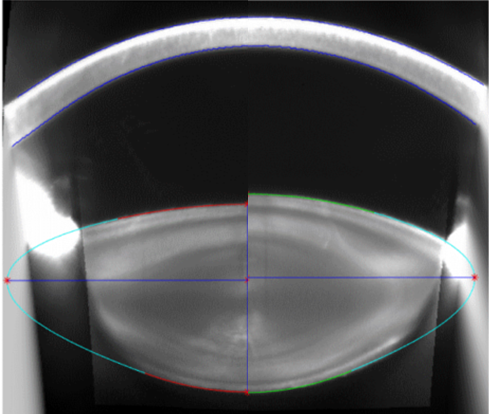Presbyopia is the progressive loss of our eye’s ability to focus on near objects as we age. At a certain point, reading glasses are needed for our daily-life activities such as reading, working on a computer or using a smartphone.
More the 2.3 billion people in the world are affected by presbyopia in 2023.

How does vision work ?
The eye is made of several optical layer that focus the light on the retina.
Like the CCD of a modern camera, the retina is made of photoreceptor that convert the light into signal for the brain, enabling vision.

Schematic trajectory of the ligt in the eye.
What is the accommodation process ?
The eye is able to adapt its optical power so it can produce a sharp picture of a distant landscape, but also focus on a closer object like a book. This optical adaptation is called the accommodation process.
The accommodation is performed by the deformation of the cristalline lens in the eye.

Double cross section of the eye from in vivo imaging : Left, the crystalline lens is flat, enabling to focus the light comming from distant object. Right, the lens is round, with a superior optical power, allowing to focus the light coming from a close object.
For instance, at the age of 20, the eye can focus easily to an object as close as 20 cm.
What causes presbyopia ?
With age, the mechanical properties of the eye tissues change. This is also true for the cristalline lens that gets stiffer, and thus harder to deform. As the amplitude of deformation decreases, the resulting amplitude of accommodation decreases.

The changes in the mechanical properties is correlated with the degradation of accomodative amplitude.
What are the effects of presbyopia ?

Example of the effect of presbyopia.
Not only the loss of the near vision can be considered as an impairment for working or daily activities, but reading glasses is seens as one of the most ubiquitous signs of aging.
How is adressed presbyopia ?
Lowly invasive solutions
Reading glasses are the most common solution. They are relatively inexpensive but have some major drawback :
– Have to be put on and off to switch from near to far vision. Can be lost.
– May be unconfortable, especially during activities such as sport
– May feel like a mark of aging
Progressive glasses allow to switch from different distance of visions without taking off the glasses, but are also more expensive, harder to prescribe. As near visions keeps on decreasing, the correction has to be changed.
Another solution are contact lenses. Their main davantage is esthetic, but they are harder to put on and off and may cause eye disconfort.
Surgical solutions
The cristalline lens can be removed chirurgically, and replaced with an implant (Intra Ocular Implant, or IOL) like for cataract surgery. Many configurations are avalaible, the most common being :
– Monofocal implant : implant with a fixed correction.
– Multifocal : 2 to 3 different distance of vision, but the amount of light focused is also reduced by the same time. Can also lead to halos and glare.
– Refractive surgery : if the cornea is thick enough, it can be reshape by a laser (like for myopia) giving an optical offset to the eye.
All these solutions have drawback :
- First, surgery is always a risk. Most of these surgeries are highly invasive.
- Price is far more expensive than simple reading glasses.
- They adress the consequence (optically) and not the root cause
- As a compromise of vision with fixed offset, they lead to optical problems (Glare, Halos, poor acuity in diminushed light conditions…)
Here are some illustration of classical side effects of intra ocular implants :

Poor visual acuity in diminushed ligth conditions.

Glare at night.

Halos at night.

